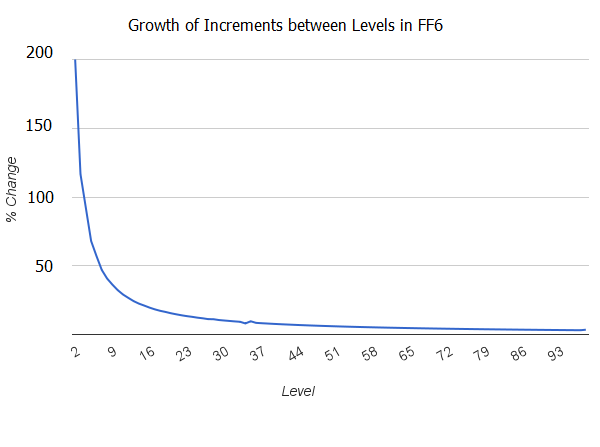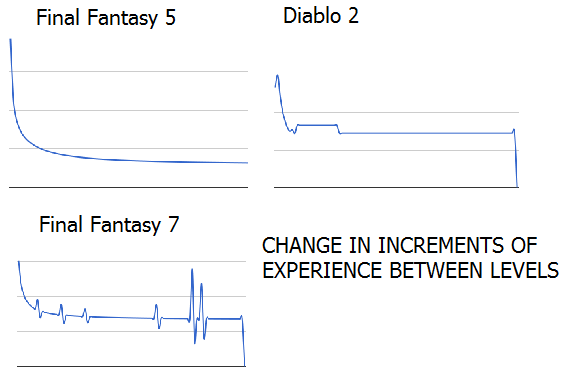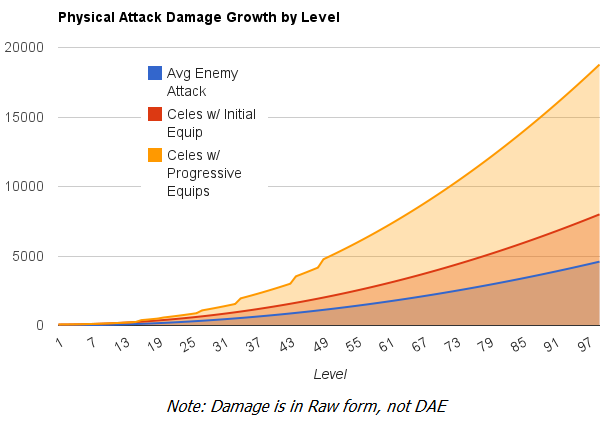Levels, Stats, and Metrics

The Short Version This section examines the level-up system, stat-points and gear of Final Fantasy 6. It is observed that FF6's level and experience system are fairly standard and in line with its non-MMO peers. The growth of EXP intervals between levels is inversely proportional to the growth of player character levels. This, it is stated, is to move the player through the first half of the game quickly, without providing a good place to grind and abuse the ratio of reward / time. An examination of stat points reveals that, because of the diminution of character classes, there is only one truly meaningful native character stat: magic power. Every other meaningful stat contribution is contributed by equippable gear; this gear is analyzed with detail.
We're going to look at the level-up structure of the game, and what it means for the player's experience. There are also a number of useful metrics in this section for measuring the performance of stats, weapons and levels. First, however, I should introduce two stats I use to measure different trends in design. The first stat is actually very simple: RAW. RAW is simply the amount of raw damage done by a character or enemy, ignoring all other variables. RAW is useful for measuring the effect of different factors upon a character's abilities. To figure in enemy defense and damage reduction, I use a different stat called DAE, or damage against the average enemy. This stat shows how effective a character's abilities are against a typical defense, which will suggest how significant various changes in RAW are against aggregate enemy defenses. Because of the standardization of stats in FF6, there are a huge number of enemies within 20% of the average defense, so this is actually very practical data. Also, I should note that almost every attack in the game is subject to random variance. The scope of the random variance isn't terribly large; it might matter to an individual player, but it doesn't matter to overall design trends. I elected, at all times, to show graphs at the highest possible output yielded by random variance for simplicity's sake. Some of my numbers might seem a bit higher than average to anyone looking closely enough, but all of the trends, slopes, percentages, fractions, etc are all accurate. Thus, we should always be able to see the design trends clearly, which is what we're after anyway.
Now, onto the analysis itself. It all begins with a graph:

This is the growth rate of the interval between level-ups in Final Fantasy 6. Some brief slices of explanatory data: to go from character level 29 to 30, a character has to gain 8200 EXP, up by about 10.1% from the last level increment, 7688 EXP. The growth of the increment between levels gets smaller, however. To go from character level 49 to 50 the player needs to gain more EXP (20,816) but that's only up about 6% from the previous level increment. And so the trend continues.
This is a common trend in level-up systems of RPGs. At first I was quite confused by the data. For example take a look at FF5 and FF7, and you see a very similar trend. But it's not just FF titles that do this. Take a look at a very different game like Diablo 2, and you see the same thing!

This is a little counterintuitive at first: why would it become easier to level up late in the game? Doesn't that make the game progressively easier when it should be progressively more challenging? As far as FF6 is concerned, the answer is no. The result of this level up curve is actually that the player characters seem to level-up at a consistent rate, not an accelerating one.
To answer how this is the case, we need to take a brief step back, and see the bigger picture. All level-up systems are founded upon two essential ratios: reward / challenge (R/C) and reward / time (R/T). Most players will recognize this instinctively: the harder a challenge is in an RPG, the greater the reward will be, usually. Obviously there are exceptions to the rule, but this is true much more often than not. In a fair level-up system, the R/C ratio will not vary too widely throughout the game. Challenges will generally yield results close to the player's expectations. The most common instance of this is in battles: EXP rewards should correlate to the difficulty of the battle. As the characters level up, battles get easier and the EXP rewards should become increasingly trivial. This decrease in reward will prompt the player to seek harder challenges that have more relevant amounts of EXP. That's the kind of design that will make sure the player sees a lot of the game.
It is still possible for players to abuse the system by taking advantage of a favorable R/T ratio. That is, players can find exceptionally easy challenges (enemies) and defeat them at such an accelerated pace, that the reward schedule becomes more favorable than normal gameplay. In the early parts of the game, enemies are exceptionally easy, so as to teach players how to use the combat system. (This fact is provable on two objective criteria. The defense of these early enemies is about 25% lower than average, and they have fewer chances to do anything at all during battle, based on the design of their AI.) It would be all too easy for players to take advantage of this necessary ease, and speedily jump several levels ahead of the design.
The level-up structure to which FF6 ascribes avoids the pitfall of early R/T abuse, and also serves a second purpose: to drive the plot. As we saw on page 2, earlier dungeons are bigger and easier. There's also a lot more talking and a lot less treasure in those early dungeons than there are in the second half. Early dungeons need move the plot quite a bit, and the player spends a lot of time in dungeons as a result. If the corresponding early levels (in FF6, anything below 25) had EXP increments between levels as small as the second half of the game, the player might gain many more levels in the first half than in the second. That would make the game feel rather lopsided.
So, for a variety of reasons essential to preserving the design, FF6 and many games like it use a gradually diminishing growth rate in the increments between level-ups. Of these reasons, however, I would say that maintaining a stable R/T ratio is the cornerstone, as games in other franchises--beyond, even, what I've mentioned here--seem to obey it as well.
LEVELS AND STATS
If a picture is worth a thousand words, an excel graph is worth a thousand words after taxes. The FF development team was presented with a problem: they needed to make stats meaningful, without breaking their game overarching game design themes. The goal was, as always, to make characters play differently, but not too differently. After all, most of the game is spent controlling one, very select party. The biggest dungeons, however, involve controlling two and three parties of characters. Characters can't play too differently, or those challenges become extremely annoying, if not impossible. And what makes an RPG character play a certain role? Stats!
As it is, most character stats in FF6 don't do much in the absence of equipment. Stamina, for instance, requires an extensive amount of investment in order to reap half the benefit you get from a single accessory. Investing in the speed stat, meaningfully, requires that a character eschew all other stats; it's problematic, and the effect could be achieved with a simple cast of Haste 2. HP and MP investments are okay, although they don't increase the overall durability of a character that much--a fact that we'll discuss on the next page.
What the designers did was to emphasize two things instead of stats: one of them was equipment, and the other was character levels. Below is a graph charting the relative importance of levels and equipment in modifying physical attack damage.
The top line is weapon upgrades; you can see how the slope is steeper than anything else below. Weapon upgrades give not only more power, but each weapon upgrade gives a larger proportion of power than the previous weapon. Not so much with pure levels. The second (red) line shows how one weapon's output scales across levels. The slope gets steeper, but much more slowly, and the absolute amount of endgame damage is, of course, nowhere near its weapon-upgraded counterpart.

Want to read more? The rest of this section can be found in the print and eBook versions. In fact, the print version of this book has been significantly expanded and revised.